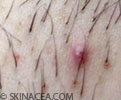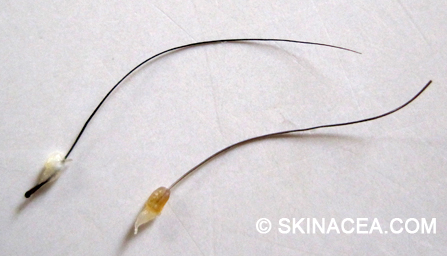How to Get Rid of Ingrown Hairs
Fast and easy way to prevent and treat ingrown hairs |

Ingrown hairs are hairs that curl and grow back into your skin after shaving or waxing. They cause redness and irritation and make your skin feel bumpy instead of silky smooth.
You can get ingrown hairs anywhere you grow hair, whether it's ingrown leg hair, ingrown pubic hair, ingrown armpit hair, or ingrown facial hair. People with naturally coarse and curly hair tend to be more prone to getting ingrowns, but really, anyone can get them and tons of people do.
Not removing hair is the easiest way to avoid getting ingrowns. However, if that is not an option, follow these easy tips to prevent and get rid of ingrown hairs fast:
Step 1: PREVENT Ingrown Hairs
- Use gentle products. Whether it's the skin on your face or the skin on your body, avoid using products that have a high alcohol content or are overly drying. If your cleanser, soap, or body wash makes your skin feel tight after rinsing, switch to a gentler product. When your skin is dry, it amplifies skin irritation and can worsen any ingrown hairs you already have. Also, avoid using water that is too hot because it can be both irritating and drying.
- Prep your skin properly. Shave, wax, or epilate after you shower. Steam and water from your shower will help soften the hair and make it easier to remove cleanly. You might even want to gently exfoliate your skin to remove any dead skin cells and other buildup so you get a cleaner shave, but this will depend on how sensitive your skin is because doing so might actually cause more irritation for some people.
- Change your hair removal technique. Ingrown hairs are more common if you wax, tweeze, or epilate your hair. Pulling the hair completely out of its follicle can sometimes change the direction the hair grows. Pulling the hair completely out also means the hair has to "start over" and when it's growing and pushing through your skin. Sometimes it can't push all the way through your skin, so it curls inward to continue growing longer. You can still wax, tweeze, and epilate (since those techniques enable hair to not grow back as fast) but make sure you follow up with some kind of treatment (see below) to prevent your hair from getting ingrown.
Even if you shave, you can still get ingrown hairs. Some people are just more prone than others. To prevent ingrown hairs when shaving, make sure you don't shave too closely or too frequently. Use a sharp, clean blade (but be careful!) and shave with the grain in the direction your hair grows instead of against it.
Note: If regular razors aren't cutting it, try using a straight razor. These shave better (especially if you have really thick hair), but they can take some time to get used to. They are also initially more expensive than those three or four-blade razors you can buy at the store. However, they end up being more cost-efficient in the long run because what you pay for up front ends up being cheaper than all the replacement blades you have to buy.
- Exfoliate and moisturize daily. Exfoliating your skin (either with a BHA body wash, a loofah, or dry skin brushing) will help your skin cells shed faster, prevent dead skin cells from building up, and keep hair follicles clear.
Moisturizing will keep your skin soft and smooth and it will encourage hair to push through your skin instead of curling back inwards. Cocoa butter or shea butter is great for moisturizing body skin. Using a treatment (see below) daily, even if you don't have current ingrown hairs, will also prevent you from getting them in the future.
Step 2: TREAT Ingrown Hairs
- Get the hair out. Once you get an ingrown hair, stop shaving or waxing and let the hair grow out for a bit. When the hairs have finally grown out, you can shave or wax again. Alternatively, disinfect a pair of tweezers with some rubbing alcohol and carefully use the tweezers to pull out the ingrown hair that is curled inside your skin. Don't pluck the hair out completely or it will cause irritation and the hair that grows in its place may end up being ingrown as well. Just pull enough of the hair out of your skin to straighten it out. As soon as the curled part of the hair is out of your skin, the bump and irritation from the ingrown hair will go away.

Sebum clogging the hair follicle of a pulled-out ingrown hair
If you can't even grasp the hair to pull it out, don't try to dig into your skin to get it out because that will break your skin and make it red or even bleed. Wait a few more days until your skin sheds more or until the hair grows longer before attempting to pull it out again. Using a tweezer to pull out an ingrown hair is better to do for ingrown hairs you get on your arms, legs, armpits, and pubic hair since hair and skin there is usually thicker. For ingrowns on your face, where skin is more delicate, you have to be much more careful.
- Soothe irritated skin. If your ingrown hairs are particularly irritated and red, avoid shaving, waxing, or exfoliating. Doing so when your skin is inflamed will only make things worse. Try putting some aloe vera gel on your skin to soothe the redness. Hydrocortisone cream can also reduce any irritation. You definitely don't want your skin to be hot and prickly! Wait until your hair grows longer and skin calms down before you attempt another hair removal session.
- Treat with an active. Treating ingrown hairs with an active ingredient will help them go away faster. Manual exfoliation is good for preventing ingrown hairs, but manually exfoliating ingrown hairs (i.e. using a scrub) that are already on your skin may actually backfire and irritate your skin even more. Instead, chemical exfoliants are better for treating current ingrown hairs:
You should see an improvement in your ingrown hairs after 3-4 days of using an active treatment. Keep in mind that chemical exfoliants like AHAs will make your skin more sensitive to the sun, so it will also be best to wear a protective sunscreen.- Use a treatment with salicylic acid (BHA) or glycolic acid (AHA). This can be an acne treatment product for your face that you use on your body or a body lotion with BHA or AHA in it. Alternatively, using an after-shave product or making your own can also help.
- For individual and super stubborn ingrown hair bumps, like the ones you get from your pubic hair, put some acne cream (with salicylic acid or retinoid as the active ingredient) 2x a day on the ingrown hair. It's okay to be more aggressive with this kind of spot treatment because body skin tends to be thicker.
- Use a treatment with salicylic acid (BHA) or glycolic acid (AHA). This can be an acne treatment product for your face that you use on your body or a body lotion with BHA or AHA in it. Alternatively, using an after-shave product or making your own can also help.
- Moisturize liberally. Moisturize your skin, even if it doesn't feel dry, to help soothe irritation and make ingrown hairs go away faster. Moisturize after you put on the active treatment and before you go to bed. Doing so will keep your skin soft so your hairs can push out of your skin and your skin can heal. If you use an active like BHA to treat the ingrowns, the active might actually make your skin drier, which is why it's extra important to moisturize your skin liberally.
Ingrown hairs can be a big pain, but following the above tips will help you prevent them from occurring and make any ingrown hairs you have go away even faster.
Last updated: June 7, 2013
How to Get Rid of Stretch Marks
Back « How To's
Related articles:
- How to Dry Skin Brush
- How to Get Rid of Keratosis Pilaris
- Body Acne Map: Clear Your Body Skin Today
- Four Golden Rules for Beautiful Skin
- Wear Sunscreen the Right Way
